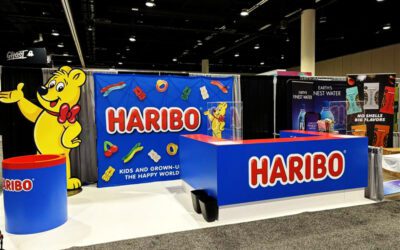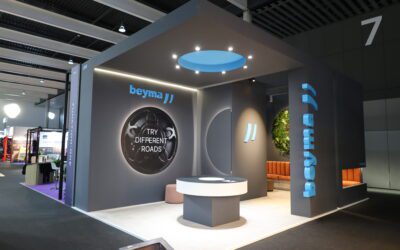For most businesses, exhibiting at a trade show is a major investment. So what do you need to consider that will deliver the most bang for your buck?
Catarina Hoch is vice president of global marketing at Operatix and the host of B2B Revenue Acceleration: The Podcast for Technology Leaders. On a recent episode, Catarina talked with Jay Menashe, senior vice president of sales and marketing at EDE, about what goes into getting the best return on your trade show efforts.
Click below to watch the complete interview:
How to Maximize the ROI of Tradeshows | Jay Menashe | B2B Revenue Acceleration
Section Links:
- Effective Pre-Show Promotion
- Crafting an Attention-Grabbing Booth
- Messaging
- Swag
- Measurement and Metrics
- Prospect Engagement
- Following Up
1. Effective Pre-Show Promotion
Getting your prospects fired up about visiting your booth ahead of the show is the first step and is the starting point for aligning sales and marketing in the process. Start pushing the show six weeks out to get the best results.
- Prepare your core messaging in advance. Be specific about what you’ll be showcasing and why it matters to your prospects.
- Now’s the time to begin a solid email marketing campaign that communicates key touchpoints about your exhibit.
- Add calls to prospects using scripts based on your messaging platform.
- This is a great time to start promoting the show on your social media platforms. Regular posts that reiterate your messaging will help inform and create excitement.
- Don’t forget to include local professional and business communities in your marketing. Networks such as Spiceworks (for IT pros) are an excellent avenue for getting the buzz going about your offering and allow more targeted engagement.
Crafting an Attention-Grabbing Booth
Trade shows are busy places with a lot of noise, lots of color, and hundreds of exhibitors vying to stand out. How do you communicate your brand message in ways that will make your booth the must-see of the show?
In most B2B interactions, prospects are looking at a website, reading a brochure, or talking with someone on a phone. Trade shows offer the unique opportunity to bring your brand to life in a physical space. That’s an opportunity you can’t afford to waste!
If you’re showing up with cheap looking, wrinkled fabrics on a broken down booth, that’s how you’re representing the quality of your brand. If that’s what you’re putting on display, hopefully you’ve got a cheaper price point!
If you’re selling to enterprise-level clients, you need to show up with a booth that presents you in a way that resonates with them.
Putting some serious thought into your exhibit is the key to a successful show experience and should start at least 6-9 months out. This will allow enough time to choose a location on the floor, establish a budget, choose suppliers, and prepare your booth. Because some shows require selecting your booth space a year in advance, contact the show operator early to determine their requirements.
If you’re planning a brand new booth, that 6-9 month window breaks down to:
- 1-2 months for design. Design and graphic elements always take time to finalize.
- Several weeks for pricing and negotiation.
- 8-16 weeks (depending on size and complexity) for fabrication.
- Typically 1-2 days (depending on size and complexity) for installation.
Using an existing booth can reduce your timeline to 4-6 months but you still should allow sufficient time to account for repairs, updates, logistics, and other considerations.
Because what goes into the design of a booth is subjective, nothing is ever 100% and final decisions can depend on many factors, such as the number of stakeholders involved. Pricing also raises questions, because of the size of the investment.
Messaging
Walk through most any trade show and you’ll be underwhelmed by the vague, bland messaging out there. It’s all about “We Do This”, when clients are looking for an answer to “What’s In It For Me?” If your brand messaging isn’t answering their question, don’t be surprised when they pass you by without a second glance.
EDE uses a process called Designing for Decision Makers. We use analytical design and craft the second tier of messaging from just a brand message to speaking specifically to your audience.
As an example, Jay shared that at NRF, the National Retail Federation’s Big Show in New York City, one company’s graphics showed a case study that demonstrated how they saved Gap Inc. 85%, which was very specific.
Most visitors will see that and decide they’re not a fit for this company. But remember, they’re clearly only speaking to a certain level of prospect.
Being specific in your messaging can aid in qualifying booth visitors where you’re not just saying “We’re the best provider of XYZ!” Which doesn’t say anything to anybody.
One important aspect of trade shows is that, even if you’re scheduling meetings six weeks out, 30-40% of the meetings you’re holding on-site are people that are just walking by. You’ve got roughly 3-5 seconds to grab their attention and say something that’s going to compel them to start a conversation with you!
Swag
You can fight it – but everybody’s going to have it! Swag is a must but it could be improved in most cases. Here’s a better approach to swag with three different strategies for three different types of visitors.
Parents. These are the people who expect to come home with gifts for their kids. You should provide something of quality for these visitors, like a stuffed animal or something fun and playful. It can’t be cheap or fall apart within a week.
Road warriors. Quality gifts for these folks; give them something useful they can keep for a long time. Jay recalled a case he received at a show. He stated that he will never forget the company and that he keeps it with him all the time.
Hungry attendees. People love food and they’re willing to wait in line for it. Food lines present an opportunity to have easy, unguarded conversations with prospects. It’s not time for a hard sell, but it’s a good place to start a conversation and relationship.
Jay mentioned that at a Healthcare Information and Management Systems Society (HIMSS) show, one company had a nitrogen ice cream bar. It tied to their cloud offering because you could see the cloud from the nitrogen. It was very tasty and there was probably a 20-30 person line at all times.
Measurements and Metrics
Everybody goes to trade shows to promote their brand, drive business, and meet with clients. What metrics should you be tracking to evaluate the success of the show? It’s a complex answer and always depends on why you are there. Lead scans, meetings held, and dwell times can help deliver positive ROI on your efforts.
- Scanning badges just to say look at how many people saw our booth and brand by itself is a fake awareness measurement.
- Ask 3-5 closed end questions to qualify booth visitors. This will make it easy and actionable for your sales team to follow up.
- Meetings held on-site are a meaningful metric.
- Are they a net new prospect or somebody already in your opportunity pipeline?
- Use technology to measure how much time they’re spending in your booth (dwell time); the longer they’re there, the more likely they are to turn into an opportunity or make a purchase.
- RFID (radio-frequency identification) tech won’t give names or demographics, but it will speak to the flow of your booth and how it’s working, and will help identify which products or services are more popular.
Best Practices for Prospect Engagement
- With 30-40 percent of booth traffic comprised of people that are just passing by, consider how you can better engage with real prospects.
- Eye contact is not a true indication of interest. “You made eye contact – you have to talk to me now!”
- Starting a conversation is key, but you don’t want to trick visitors. It’s about asking those 3-5 closed-end questions. If you’re getting meaningful answers, they’re at least worth having a two-three minute conversation to qualify them a little deeper.
- After your initial questions, you can move on to more open ended questions and, based on their answers, move them further along the process.
And the Winner Is!
Creating a competitive game experience has become an effective draw for exhibitors. Many companies use The Price is Right types of games, such as Plinko or spinning a wheel, because people naturally love competition! It’s an easy way to drive people to your booth and get their information on at least a surface level.
Jay talked about a company called MHS at ProMat, the warehouse automation show. They had stopped bringing their massive machines and had EDE create a Wordle game for them. Winners got to see their solution tap the robotic arm which would take a prize out of a bin that was sorted by their sorting machine. Then it was placed on their conveyor belt and brought to the winner. It was a great way to engage visitors with the mechanics of their software and machinery at work.
He recalled another company that set up a Lego maze. Their tagline was “We will get you through the maze of healthcare paperwork.” Visitors received a fishing rod and a character and were led through the maze. If you and your character make it through, you got to choose one of a hundred Lego characters to take home with you.
Whether it’s an analog or digital solution, there are hands-on ways to get people to understand your product in a simple way that’s more engaging than a PowerPoint or just someone talking in a theater presentation. What will you offer?
Best Practices for Follow Up
Trade shows result in a pile of leads that need to be filtered through and converted into opportunities. With visitors having dozens of show conversations, the faster you get back in touch with them, the more likely they’re going to remember you and your conversation.
While there’s always the generic follow up email that comes from a show, give it until the beginning of the next week to start your follow up.
Reference the conversation you had and talk to the points. If you’re speaking to your conversation, it’ll be more memorable and remind them of their experience with you. Don’t wait on this step; you’re competing with every other vendor for the same audience and the same market chance. You need to find a way to stand out and do it quickly.
While none of us will forget the effects COVID had on trade shows, they are coming back fully and even stronger than before! People have been longing for human interaction and face-to-face time and that’s resulting in some really busy shows. Are you ready for the opportunity?
Stay on the cutting edge of what’s happening in the trade show world on our LinkedIn page. Browse our Knowledge Hub for how-tos, trade show recaps, and more.


